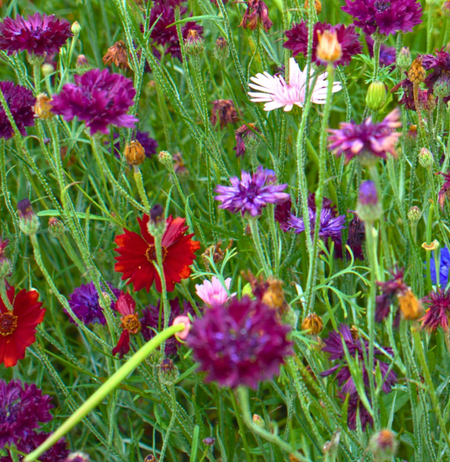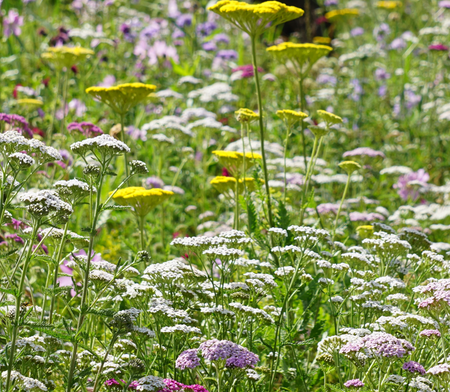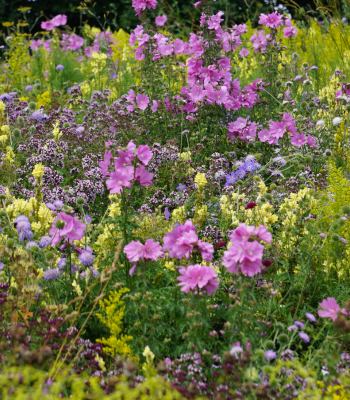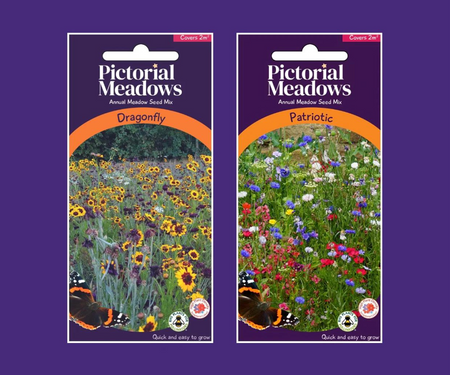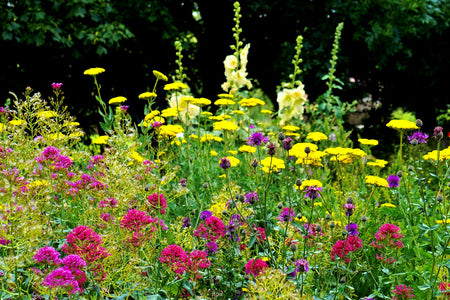Are perennial meadows by seed relatively easy to grow, especially if I have little gardening experience?
No, perennial meadows from seed, whilst cost effective and stunning, are not the easiest solution for less confident gardeners to start with. Consider starting with an annual meadow or using Pictorial Meadows turf if you do not want to be very actively engaged in careful preparation and establishment.
When is the best time to sow perennial seeds?
The best time to sow perennial seeds is autumn, specifically anytime from early September to November. This is because the ground is workable and the seeds benefit from a colder spell as it aids spring germination. They can also be sown throughout winter and spring if the soil remains workable. Avoid summer sowing unless you can provide plentiful, regular irrigation.
Does the sowing time for perennial seed impact how quickly I will have a flowering meadow?
Not really. Autumn and winter sowing is beneficial because it provides an important chilling period that helps more seeds germinate in spring. Whatever the sowing time though, vigorous establishment growth won’t happen until the soil really starts to warm up – normally from April onwards. Spring/summer sowings can give you rapid germination if the soil is warm and moist, but a greater percentage of seed may remain dormant until autumn or the next spring. In general, though, whatever the sowing time, you should start to enjoy some colour by mid-summer, although the main impacts won’t be experienced until the second growing season.
Can I mix annual seed with perennial seed?
We don’t advise this. All our perennial mixes already contain a very small percentage of a few select annuals, but we keep this amount to the bare minimum. If you are trying to establish a proper perennial meadow, unless it is on extremely low fertility soils, annuals in any greater amounts will very quickly out-compete and overshadow the slower emerging perennials. Ultimately this prevents a successful long-term sward establishing.
Will my meadow look exactly like the pictures I have seen?
No, even though the mix recipe will be the same, everyone’s meadow will develop its own unique characteristics, and these will continue to change throughout the year, and year to year.
Do I need to protect the seed from mice, squirrels and birds?
Only very rarely. We have sown hundreds of meadows that have never shown any predation by birds or other animals but that doesn’t mean it can’t ever happen.
Will soil fertility affect my perennial meadow?
Yes, it will. Many Pictorial Meadows mixes have been specially designed to perform on normal fertility soils common to most gardens and parks whilst others are only recommended for lower fertility soils. The richer the soil, the taller and bushier the plants will be, especially in the first few years. It is best to select a mix to start with that best suits your soil, to sustain the annual cut and collect, and to bring in an additional early summer cut and collect in some cases if growth is too vigorous. Removing the cut material will gradually reduce the fertility of the soil. After a few years on even the most fertile soils, you will see the composition and structure changing and the emerging meadows look finer and shorter.
Can I sow my perennial seeds over existing grass?
No. Not starting with clean cultivated soils which are especially clear of grass is probably one of the greatest reasons why young perennial seed-sown meadows fail. Always sow on bare, clean, cultivated soils.
Can I mix the perennial seed with grass to make it go further?
No. Grass is very competitive and will quickly dominate all the slower growing perennial seedlings. It is almost impossible to keep wild grasses spreading into meadows over time, so you will eventually get some grass. The less you have, especially in the first few years whilst the perennial plants are getting well established, the better.
Do I need to irrigate my perennial meadow seeds and seedlings?
Yes, irrigation can make a very big difference to perennial meadow success. The critical period is late spring to mid-summer whilst the bulk of the young seedlings are emerging. Once you can see a good range of species establishing and the ground is starting to look more green than brown, irrigation can stop.
What happens if I sow less or more than the recommended rate?
It’s best to stick to the 2g per square metre rule as that’s how we’ve formulated the meadow designs. Do not under-sow a perennial meadow as you won’t get the all-important number of species to grow and cover the ground.
Is it necessary to sow onto sterile mulch?
No, but it can make a very significant difference to the success of your perennial meadow. Whilst you won’t be able to spot them, natural soils can contain huge quantities of weed seeds. Many lie dormant for years, but when brought closer to the surface as you prepare your ground to sow your perennial meadow, these weed seedlings will also start to grow and can very quickly swamp your slower meadow seedlings. A sterile, low fertility mulch will sit on top of your cultivated soil, acting as an effective weed seed barrier. You then sow your perennial seed onto the top of it. This also gives you confidence that all the seedlings you then see emerging are the desirable ones.
Are establishment cuts in the first year necessary?
No, but it can make a very significant difference to the success, especially the species diversity of your perennial meadow. Every species in your mix needs a slightly different set of triggers that allow it to germinate and grow. We formulate the mix carefully to encourage the greatest range of species to all thrive together, but it is necessary to check the faster and bushier ones to allow slower and finer ones to get a foothold. An establishment cut checks any invading annual weeds and stops the faster growing or emerging perennials from dominating. Essential light and water reach the slower growing species and allows them to catch up. It also encourages basal shooting and stronger root development, which in turn helps to close out bare ground. Once you get to the end of the first growing season and there is a good range of species present, they are all remarkably resilient, but they really do need this initial helping hand.
Do you ship worldwide?
No, but you can purchase the Pictorial Meadows seed mixes through our European agents Florum DK and Bloomingfields.

